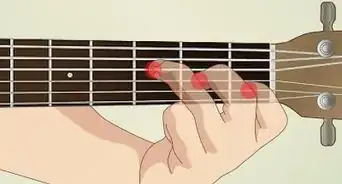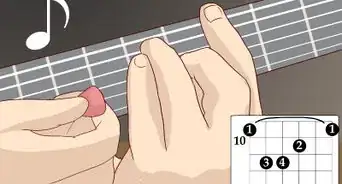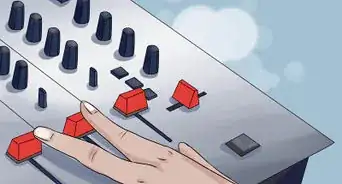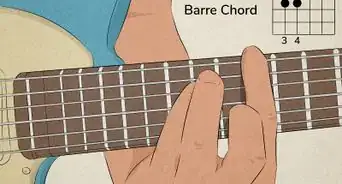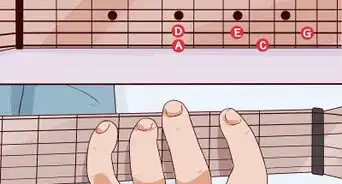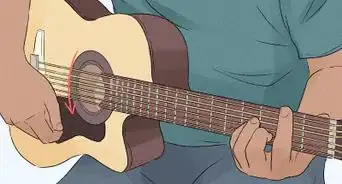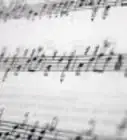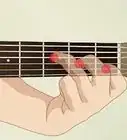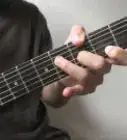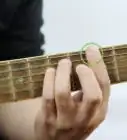This article was co-authored by Aaron Asghari. Aaron Asghari is a Professional Guitarist and the lead guitarist of The Ghost Next Door. He received his degree in Guitar Performance from the Guitar Institute of Technology program in Los Angeles. In addition to writing and performing with The Ghost Next Door, he is the founder and primary guitar instructor of Asghari Guitar Lessons.
This article has been viewed 29,567 times.
Power chords are the easiest way to learn most songs quickly. Simple, easy to adjust, and fast, power chords are two to three string mini-chords that can be played across the entire fretboard if you know one simple chord shape. While they are not the most harmonically or melodically unique chords, they are still a staple of most of popular music's guitar parts.
Steps
-
1Memorize the notes on the top two strings. A power chord is simply a two to three note chord that can be used in major or minor key songs. The placement of your index finger determines which chord you are playing. So, if you're on the sixth string, third fret, you're playing a G power chord. If you're on the fifth string and fifth fret, you're playing a D power chord, and so on.
- This is called the chord's "root note." It dictates the rest of the chord.
-
2Place your index finger on your root note. Simply fret this not like you would fret any other note. Move your finger close to the fret for the best sound, holding it down with the tip of your finger.
- --X--
- --X--
- --X--
- --X--
- --X--
- --3--
Advertisement -
3Fret the note one string down, two frets over with your ring finger. If you're right-handed, this is the note a string down and two frets to the right. If you're on the sixth string, third fret with the index finger, you want to put your index finger on the fifth string, fifth fret.
- --X--
- --X--
- --X--
- --X--
- --5--
- --3--
-
4Add an octave of the root note for a fuller, richer chord. This note, playing by barring your ring finger or using your pinky, is a thicker sounding chord. However, it is a bit slower to play and doesn't always sound good with distortion. Use the two string version for faster, harder songs and the three string version for everything else. Your final chord would look like this:
- --X--
- --X--
- --X--
- --5--
- --5--
- --3--
-
5Only strum the strings you've fretted. Any string that isn't being fretted should be ignored. The exception, of course, are for power chords that start on the open E or open A string.
- Focus on only strumming the top strings, angling your pick slightly out to avoid the lower strings.
- IT can also help to let your index finger drape over the bottom strings, dampening them so they don't make noise when strummed.
-
6Move your root note to make any power chord on the top two strings. Once you've got this form down, all you have to do is move it to a new root note to change the chord. If you want to form a D# chord, just start on the 5th string, 6th fret, and put your ring finger on the 4th string, 8th fret. It is that easy!
- Power chords are usually written as a "Fifth chord," such as G5, or D#5. If you see these chords in written music, play a power chord starting at the root note, such as a G or D#.
Expert Q&A
-
QuestionHow do you play a D chord?
 Aaron AsghariAaron Asghari is a Professional Guitarist and the lead guitarist of The Ghost Next Door. He received his degree in Guitar Performance from the Guitar Institute of Technology program in Los Angeles. In addition to writing and performing with The Ghost Next Door, he is the founder and primary guitar instructor of Asghari Guitar Lessons.
Aaron AsghariAaron Asghari is a Professional Guitarist and the lead guitarist of The Ghost Next Door. He received his degree in Guitar Performance from the Guitar Institute of Technology program in Los Angeles. In addition to writing and performing with The Ghost Next Door, he is the founder and primary guitar instructor of Asghari Guitar Lessons.
Professional Guitarist & Instructor On your fretting hand, place your first finger on the 2nd fret of the G string. Then, place your third finger on the 3rd fret of the B string. Finally, place your second finger on the 2nd fret of the high E string. Strum from the D string through the first four strings in a flicking motion to play your D chord.
On your fretting hand, place your first finger on the 2nd fret of the G string. Then, place your third finger on the 3rd fret of the B string. Finally, place your second finger on the 2nd fret of the high E string. Strum from the D string through the first four strings in a flicking motion to play your D chord. -
QuestionHow do I create a power chord on the keyboard or piano?
 80_CaloCommunity AnswerPlay the root note and its fifth simultaneously. If you want to play a C power chord, then play C and G simultaneously.
80_CaloCommunity AnswerPlay the root note and its fifth simultaneously. If you want to play a C power chord, then play C and G simultaneously. -
QuestionWhat are the notes on the top two strings?
 FreeAdvice.ComCommunity AnswerThe top two strings on a guitar (the thickest ones) are E and A.
FreeAdvice.ComCommunity AnswerThe top two strings on a guitar (the thickest ones) are E and A.
